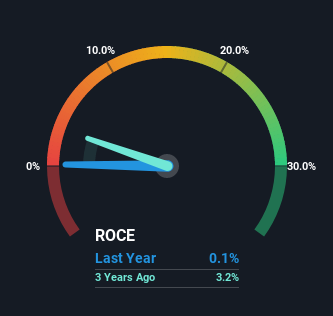- United States
- /
- Telecom Services and Carriers
- /
- NasdaqGS:SHEN
Returns On Capital Signal Difficult Times Ahead For Shenandoah Telecommunications (NASDAQ:SHEN)
If we're looking to avoid a business that is in decline, what are the trends that can warn us ahead of time? When we see a declining return on capital employed (ROCE) in conjunction with a declining base of capital employed, that's often how a mature business shows signs of aging. Trends like this ultimately mean the business is reducing its investments and also earning less on what it has invested. In light of that, from a first glance at Shenandoah Telecommunications (NASDAQ:SHEN), we've spotted some signs that it could be struggling, so let's investigate.
Understanding Return On Capital Employed (ROCE)
For those that aren't sure what ROCE is, it measures the amount of pre-tax profits a company can generate from the capital employed in its business. To calculate this metric for Shenandoah Telecommunications, this is the formula:
Return on Capital Employed = Earnings Before Interest and Tax (EBIT) ÷ (Total Assets - Current Liabilities)
0.0014 = US$1.2m ÷ (US$891m - US$71m) (Based on the trailing twelve months to June 2022).
So, Shenandoah Telecommunications has an ROCE of 0.1%. Ultimately, that's a low return and it under-performs the Wireless Telecom industry average of 6.1%.
Check out our latest analysis for Shenandoah Telecommunications

In the above chart we have measured Shenandoah Telecommunications' prior ROCE against its prior performance, but the future is arguably more important. If you'd like to see what analysts are forecasting going forward, you should check out our free report for Shenandoah Telecommunications.
What Does the ROCE Trend For Shenandoah Telecommunications Tell Us?
The trend of ROCE at Shenandoah Telecommunications is showing some signs of weakness. The company used to generate 4.1% on its capital five years ago but it has since fallen noticeably. On top of that, the business is utilizing 38% less capital within its operations. The combination of lower ROCE and less capital employed can indicate that a business is likely to be facing some competitive headwinds or seeing an erosion to its moat. Typically businesses that exhibit these characteristics aren't the ones that tend to multiply over the long term, because statistically speaking, they've already gone through the growth phase of their life cycle.
In Conclusion...
In summary, it's unfortunate that Shenandoah Telecommunications is shrinking its capital base and also generating lower returns. Investors haven't taken kindly to these developments, since the stock has declined 32% from where it was five years ago. Unless there is a shift to a more positive trajectory in these metrics, we would look elsewhere.
On a final note, we've found 1 warning sign for Shenandoah Telecommunications that we think you should be aware of.
If you want to search for solid companies with great earnings, check out this free list of companies with good balance sheets and impressive returns on equity.
New: Manage All Your Stock Portfolios in One Place
We've created the ultimate portfolio companion for stock investors, and it's free.
• Connect an unlimited number of Portfolios and see your total in one currency
• Be alerted to new Warning Signs or Risks via email or mobile
• Track the Fair Value of your stocks
Have feedback on this article? Concerned about the content? Get in touch with us directly. Alternatively, email editorial-team (at) simplywallst.com.
This article by Simply Wall St is general in nature. We provide commentary based on historical data and analyst forecasts only using an unbiased methodology and our articles are not intended to be financial advice. It does not constitute a recommendation to buy or sell any stock, and does not take account of your objectives, or your financial situation. We aim to bring you long-term focused analysis driven by fundamental data. Note that our analysis may not factor in the latest price-sensitive company announcements or qualitative material. Simply Wall St has no position in any stocks mentioned.
About NasdaqGS:SHEN
Shenandoah Telecommunications
Provides broadband services and video and voice services in the United States.
Very low risk and overvalued.
Similar Companies
Market Insights
Community Narratives


Recently Updated Narratives


MINISO's fair value is projected at 26.69 with an anticipated PE ratio shift of 20x


The Quiet Giant That Became AI’s Power Grid


Nova Ljubljanska Banka d.d will expect a 11.2% revenue boost driving future growth
Popular Narratives


The company that turned a verb into a global necessity and basically runs the modern internet, digital ads, smartphones, maps, and AI.


MicroVision will explode future revenue by 380.37% with a vision towards success



